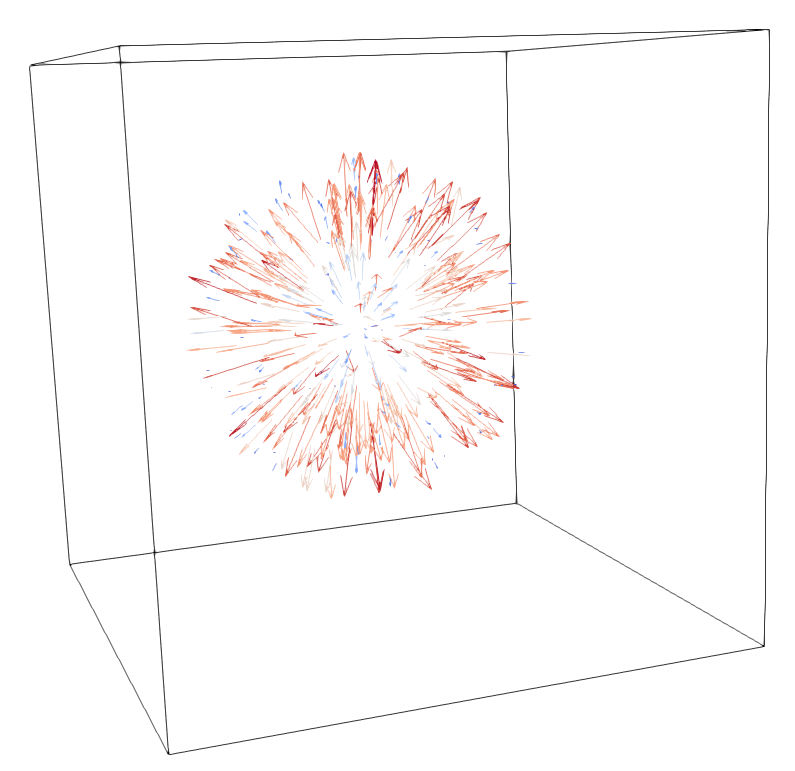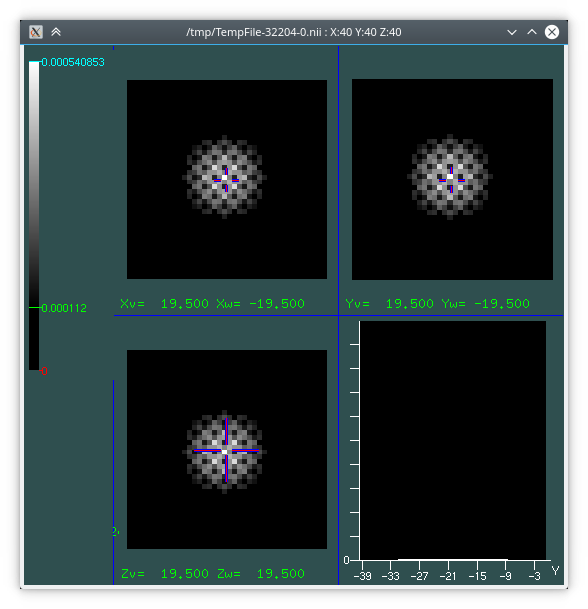Generate displacements fields with known volume changes
Project description
disptools
Generate displacement fields with known volume changes
This library provides utilities to generate and manipulate displacement fields with known volume changes. It implements three search-based algorithms for the generation of deformation fields, along with a small collection of utility functions.
The three algorithms implemented are referred as:
gradient: a gradient descent method (default).greedy: a greedy search method based on the method proposed in [1].matching: a volume matching routine based on gradient descent, published in [2] and [3]. The implementation comes from the atrophysim tool.
The library is built on top of SimpleITK, in order to provide a simple yet powerful set of functionalities for image analysis. Images stored as numpy arrays can be easily converted from and to SimpleITK and ITK image objects.
Documentation
The complete documentation for this package is available on https://martinopilia.com/disptools.
Architecture
The project is structured in three layers:
- a pure standard C99 library (whose headers are in
src/headers/), with no external dependencies, implementing the core algorithms for the generation of deformation fields. It is a standalone library that can be directly included in a C or C++ project. - a Python C extension package
_disptools(whose source is in the filesrc/_disptools.c), providing a bare Python wrapper to the aforementioned library, using the NumPy C API to pass arrays. This can be directly included in a Python project with no dependencies other than NumPy. - a Python package (
disptools), that wraps the_disptoolspackage providing file IO (through SimpleITK) and implementing high-level features (such as the multi-resolution framework) and auxiliary utilities and functions.
Requirements
The library is a cross-platform Python 3.5+ package, with a compiled C extension. The Python dependencies are:
Build dependencies are a standard C99 compiler (tested with gcc 7.3 on Linux, mingw-w64 7.2 on Windows 10), the numpy and the setuptools packages. scikit-build may be required to build the other Python dependencies.
Some optional dependencies are required only for a limited set of features, and the package should build and run without them:
- itk (pypi package): for
disptools.drawing.sitk_to_itk - vtk (pypi package): for
disptools.io.write_vtk_points - ply (pypi package): for
disptools.io.read_elastix_parameters - scikit-image (pypi package): to run the unit tests
Install
This package is available on PyPI both as source distribution and as a Windows pre-compiled binary wheel. You can install it with pip:
python3 -m pip install disptools
Build from source
Linux
Install the dependencies with your favourite package manager. For example, with pip:
python3 -m pip install scikit-build numpy scipy SimpleITK
The package provides a setuptools based install script. To install the library, run from the project root folder
python3 setup.py install
which should build the C extension and install the Python package.
Windows
-
First, be sure that the Python executables are in your PATH.
-
Since
msvc(Visual Studio) does not support the C99 standard, this package should be compiled with mingw (or any other C99-compliant compiler of your choice; in the following, instructions formingware provided). Installmingwand add its binary folder to your path. Ensure thatgccis working correctly:
> gcc --version
gcc (x86_64-posix-seh-rev1, Built by MinGW-W64 project) 7.2.0
Copyright (C) 2017 Free Software Foundation, Inc.
This is free software; see the source for copying conditions. There is NO
warranty; not even for MERCHANTABILITY or FITNESS FOR A PARTICULAR PURPOSE.
- Ensure that
distutilscorrectly recognises your version of Visual Studio (even when usingmingw). Open the fileC:\Users\yourname\AppData\Local\Programs\Python\Python3x\Lib\distutils\cygwinccompiler.py(the exact location may vary according to your setup) and check that your version of Visual Studio is present in the functionget_msvcr(); if not, adjust it according to the following:
def get_msvcr():
"""Include the appropriate MSVC runtime library if Python was built
with MSVC 7.0 or later.
"""
msc_pos = sys.version.find('MSC v.')
if msc_pos != -1:
msc_ver = sys.version[msc_pos+6:msc_pos+10]
if msc_ver == '1300':
# MSVC 7.0
return ['msvcr70']
elif msc_ver == '1310':
# MSVC 7.1
return ['msvcr71']
elif msc_ver == '1400':
# VS2005 / MSVC 8.0
return ['msvcr80']
elif msc_ver == '1500':
# VS2008 / MSVC 9.0
return ['msvcr90']
elif msc_ver == '1600':
# VS2010 / MSVC 10.0
return ['msvcr100']
elif msc_ver == '1700':
# Visual Studio 2012 / Visual C++ 11.0
return ['msvcr110']
elif msc_ver == '1800':
# Visual Studio 2013 / Visual C++ 12.0
return ['msvcr120']
elif msc_ver == '1900':
# Visual Studio 2015 / Visual C++ 14.0
# "msvcr140.dll no longer exists" http://blogs.msdn.com/b/vcblog/archive/2014/06/03/visual-studio-14-ctp.aspx
return ['vcruntime140']
else:
raise ValueError("Unknown MS Compiler version %s " % msc_ver)
-
Ensure that the library
vcruntime140.dllis present in your library path. Otherwise, download it and place it inC:\Users\yourname\AppData\Local\Programs\Python\Python3x\libs(the exact path may vary according to your setup). -
Install the dependencies:
> python -m pip install scikit-build numpy scipy SimpleITK
- Clone the sources of this package with
git, or download and extract them as aziparchive. Move to the root folder of the sources (C:\Users\yourname\disptoolsin this example), specify the right compiler, and launch the setup script to build and install the package.
> cd C:\Users\yourname\disptools
> python setup.py setopt --command=build --option=compiler --set-value=mingw32
> python setup.py install
Content
disptools.displacements: module providing the main functions for the generation and manipulation of displacement fields.disptools.drawing: collection of utilities to create test images.disptools.io: collection of utilities to read and write to file.disptools.measure: collection of utilities to measure some image features.disptools.predict: routines to interface with the PREDICT tool.disptools.simulatrophy: routines to interface with the Simulatrophy tool.
Quick example
import SimpleITK as sitk
import disptools.displacements as dsp
import disptools.drawing as drw
# Create an example Jacobian map
# A spherical ROI with a Jacobian of 1.1 (expansion)
jacobian = drw.create_sphere(10, 40, fg_val=1.1, bg_val=1.0)
# Create a binary mask for the ROI
mask = drw.create_sphere(10, 40) > 0
# Generate the displacement
displacement = dsp.displacement(jacobian, mask=mask)
# Check the correctness of the result within the ROI
error = jacobian - sitk.DisplacementFieldJacobianDeterminant(displacement)
error = sitk.Mask(error, mask)
A 3D rendering of the resulting displacement field:
And a visualisation of the the error on the Jacobian:
References
- [1] van Eede, M. C., Scholz, J., Chakravarty, M. M., Henkelman, R. M., and Lerch, J. P. "Mapping registration sensitivity in MR mouse brain images." Neuroimage 82 (2013), 226–236.
- [2] Karaçali, B., and Davatzikos, C. "Estimating topology preserving and smooth displacement fields." IEEE Transactions on Medical Imaging 23, 7 (2004), 868–880.
- [3] Karaçali, B., and Davatzikos, C. "Simulation of tissue atrophy using a topology preserving transformation model." IEEE transactions on medical imaging 25, 5 (2006), 649–652.
License
The software is distributed under the MIT license.
Project details
Download files
Download the file for your platform. If you're not sure which to choose, learn more about installing packages.
Source Distribution
Built Distribution
Hashes for disptools-0.3.0-cp36-cp36m-win_amd64.whl
| Algorithm | Hash digest | |
|---|---|---|
| SHA256 | 2485f12cea83607f643af5c763b1df2b36b02a376e3e6358ad804dc7b522f14d |
|
| MD5 | f6602a57d750e95ab1c166067b3d8025 |
|
| BLAKE2b-256 | e5a36932fbe98b0c117f3d210c69010867177414d0b24f844de8d0ddbe883cd4 |













